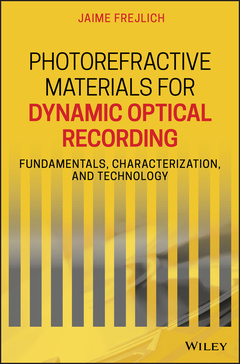Photorefractive Materials for Dynamic Optical Recording Fundamentals, Characterization, and Technology
Auteur : Frejlich Jaime

A comprehensive and up-to-date reference on holographic recording
Photorefractive Materials for Dynamic Optical Recording offers a comprehensive overview of the physics, technology, and characterization of photorefractive materials that are used for optical recording. The author, a noted expert on the topic, offers an exploration of both transient and permanent holographic information storage methods. The text is written in clear terms with coherent explanations of the different methods that allows for easy access to the most appropriate method for a specific need.
The book provides an analysis of the fundamental properties of the materials and explores the dynamic recording of a spatial electric charge distribution and the associated spatial electric ?eld distribution. The text also includes information on the characterization of photorefractive materials using holographic and nonholographic optical methods and electrical techniques, reporting a large number of actual experimental results on a variety of materials. This important resource:
- Offers an in-depth source of information on the physics and technology of all relevant holographic recording methods
- Contains text written by a pioneer in the field?Jaime Frejlich's research defined the field of dynamic holographic recording
- Presents a one-stop resource that covers all phenomena and methods
- Includes a review of the practical applications of the technology
Written for materials scientists, solid state physicists, optical physicists, physicists in industry, and engineering scientists, Photorefractive Materials for Dynamic Optical Recording offers a comprehensive resource on the topic from the groundbreaking expert in the field.
List of Figures xi
List of Tables xxxiii
Preface xxxv
Acknowledgments xxxvii
Part I Fundamentals 1
1 Electro-Optic Effect 5
1.1 Light Propagation in Crystals 5
1.2 Tensorial Analysis 8
1.3 Electro-Optic Effect 8
1.4 Perovskite Crystals 11
1.5 Sillenite Crystals 11
1.6 Concluding Remarks 17
2 Photoactive Centers and Photoconductivity 19
2.1 Photoactive Centers: Deep and Shallow Traps 20
2.2 Luminescence 28
2.3 Photoconductivity 29
2.4 Photovoltaic Effect 40
2.5 Nonlinear Photovoltaic Effect 44
2.6 Light-Induced Absorption or Photochromic Effect 48
2.7 Dember or Light-Induced Schottky Effect 51
Part II Holographic Recording 55
3 Recording a Space-Charge Electric Field 57
3.1 Index-of-Refraction Modulation 60
3.2 General Formulation 63
3.3 First Spatial Harmonic Approximation 66
3.4 Steady-State Nonstationary Process: Running Holograms 72
3.5 Photovoltaic Materials 84
4 Volume HologramwithWave Mixing 89
4.1 CoupledWaveTheory: Fixed Grating 89
4.2 Dynamic CoupledWaveTheory 92
4.3 Phase Modulation 115
4.4 Four-Wave Mixing 119
4.5 Conclusions 120
5 Anisotropic Diffraction 121
5.1 Coupled-Wave with Anisotropic Diffraction 121
5.2 Anisotropic Diffraction and Optical Activity 122
6 Stabilized Holographic Recording 125
6.1 Introduction 125
6.2 Mathematical Formulation 127
6.3 Self-Stabilized Recording in Actual Materials 135
Part III Materials Characterization 151
7 General Electrical and Optical Techniques 155
7.1 Electro-Optic Coefficient 155
7.2 Light-Induced Absorption 157
7.3 Dark Conductivity 161
7.4 Photoconductivity 162
7.5 Photo-Electric Conversion 173
7.6 Modulated Photoconductivity 175
7.7 Photo-Electromotive-Force Techniques (PEMF) 178
8 Holographic Techniques 189
8.1 Holographic Recording and Erasing 189
8.2 Direct Holographic Techniques 189
8.3 Hologram Recording 195
8.4 Hologram Erasure 195
8.5 Materials 197
8.6 Phase Modulation Techniques 205
8.7 Holographic Photo-Electromotive-Force (HPEMF) Techniques 218
9 Self-Stabilized Holographic Techniques 229
9.1 Holographic Phase Shift 229
9.2 Fringe-Locked Running Holograms 232
9.3 Characterization of LiNbO3:Fe 239
Part IV Applications 243
10 Vibrations and Deformations 245
10.1 Measurement of Vibration and Deformation 245
10.2 Experimental Setup 246
11 Fixed Holograms 257
11.1 Introduction 257
11.2 Fixed Holograms in LiNbO3 257
12 Photoelectric Conversion 263
12.1 Photoelectric Conversion Efficiency: Dember and Photovoltaic Effects 263
Part V Appendix 265
Introduction 266
Appendix A Reversible Real-Time Holograms 267
A.1 Naked-Eye Detection 267
A.2 Instrumental Detection 268
Appendix B Diffraction EfficiencyMeasurement 271
B.1 Angular Bragg Selectivity 271
B.2 Reversible Holograms 274
B.3 High Index-of-Refraction Material 275
Appendix C Effectively Applied Electric Field 279
Appendix D PhysicalMeaning of Some Parameters 281
D.1 Temperature 281
D.2 Diffusion and Mobility 284
Appendix E Photodiodes 287
E.1 Photovoltaic Regime 288
E.2 Photoconductive Regime 289
E.3 Operational Amplifier 290
Bibliography 291
Index 305
JAIME FREJLICH, Ph.D., received his PhD in Physics at Pierre and Marie Curie University in Paris, France, in 1977. He then started working as an Assistant Professor at "Gleb Wataghin" Institute of Physics at State University of Campinas, Sao Paulo State, Brazil, and retired as a Full Professor in 2016. He passed away in October 2019 after preparing this book. His research interests were in photorefractive materials, their effects, processes, and applications.
Date de parution : 02-2020
Ouvrage de 352 p.
18.3x25.7 cm



